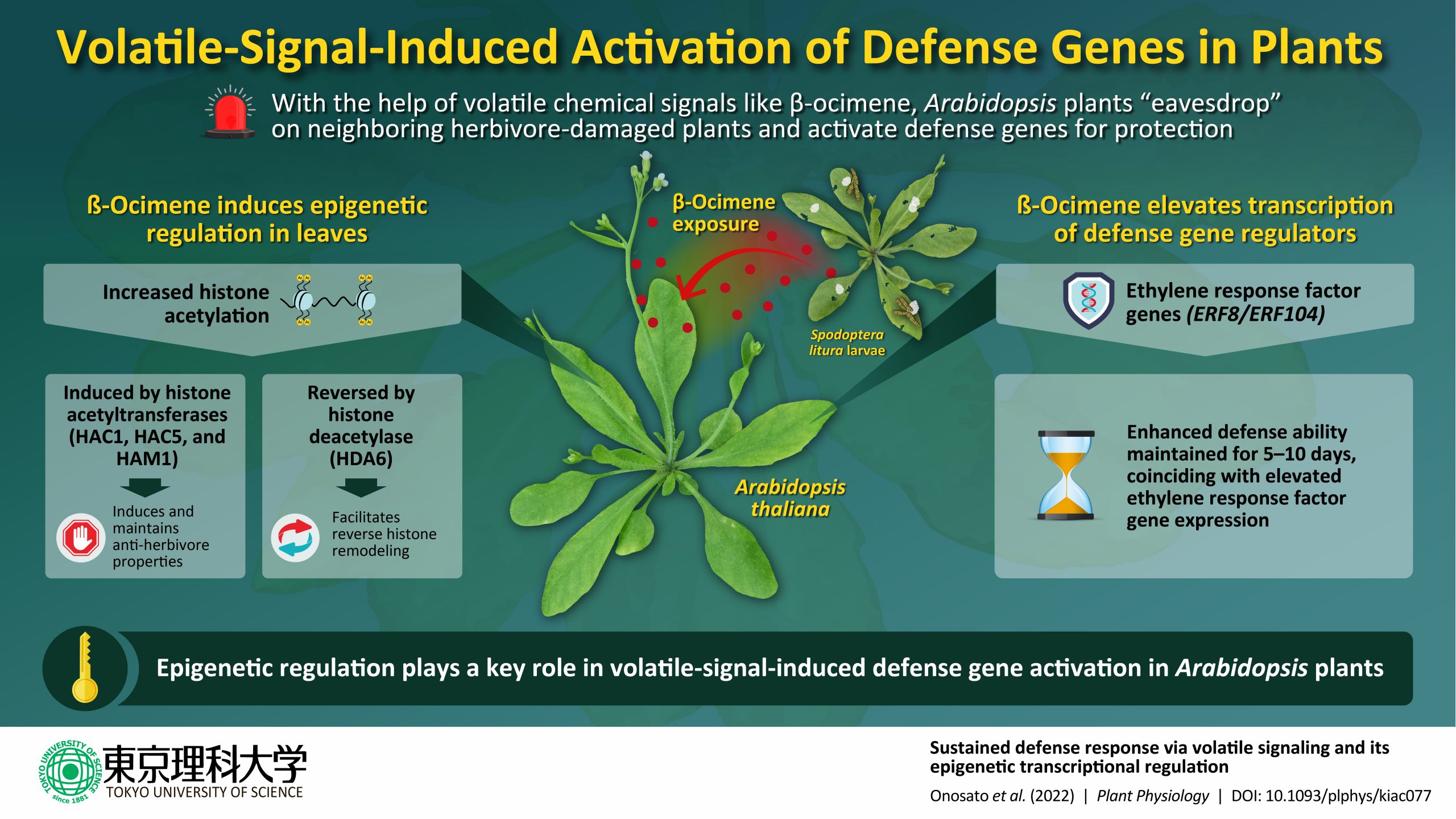Animals often use highly specific signals to warn their herd about approaching predators. Surprisingly, similar behaviors are also observed among plants.
Shedding more light on this phenomenon,
Tokyo University of Science researchers have discovered one such mechanism. Using Arabidopsis thaliana as a model system, the researchers have shown that herbivore-damaged plants give off volatile chemical “scents” that trigger epigenetic modifications in the defense genes of neighboring plants. These genes subsequently trigger anti-herbivore defense systems.
In the wild, many species of animals, especially those with known predators, signal each other of imminent dangers using a variety of techniques, ranging from scent to sound. Now, thanks to multiple studies on the topic, we have reason to believe that plants, too, can sound an alarm under threat of an attack.
Prior studies have shown that when grown near mint plants, soybean and field mustard (Brassica rapa) plants display heightened defense properties against herbivore pests by activating defense genes in their leaves, as a result of “eavesdropping” on mint volatiles. Put simply, if mint leaves get damaged after a herbivore attack, the plants in their immediate vicinity respond by activating their anti-herbivore defense systems in response to the chemical signals released by the damaged mint plant. To understand this mechanism better, a team of researchers from multiple Japanese research institutes, including Tokyo University of Science, studied these responses in Arabidopsis thaliana, a model plant used widely in biological studies.
“Surrounding undamaged plants exposed to odors emitted from plants eaten by pests can develop resistance to the pests.
Although the induction of the expression of defense genes in odor-responsive plants is key to this resistance, the precise molecular mechanisms for turning the induced state on or off have not been understood. In this study, we hypothesized that histone acetylation, or the so-called epigenetic regulation, is involved in the phenomenon of resistance development,” explains Dr. Gen-ichiro Arimura, Professor at the Tokyo University of Science and one of the authors of the study. Their findings have recently been published in the journal Plant Physiology.
First, they exposed the plants to β-ocimene, a volatile organic compound often released by plants in response to attacks by herbivores like Spodoptera litura. Next, the researchers tried to determine the exact mechanism of action of volatile-chemical-activated plant defense.
The results were interesting—defense traits were induced in Arabidopsis leaves, presumably through “epigenetic” mechanisms, which refer to gene regulation that occurs because of external environmental influences. In this case, the volatile chemicals released by the damaged plants enhanced histone acetylation and the expression of defense gene regulators, including the ethylene response factor genes “ERF8” and “ERF104”. The team found a specific set of histone acetyltransferase enzymes (HAC1, HAC5, and HAM1) were responsible for the induction and maintenance of the anti-herbivore properties.
The researchers are ecstatic about their discovery of the role that epigenetics has to play in plant defense. According to them, the communication between plants via volatile compounds (known as the "talking plants" phenomenon) can potentially be applied to organic cultivation systems. This can increase the pest resistance of plants and effectively reduce our massive dependence on pesticides.
“The effective use of plants' natural survival strategies in production systems will bring us closer to the realization of a sustainable society that simultaneously solves environmental and food problems,” concludes Dr. Arimura.
***
Reference
Title of original paper: Sustained defense response via volatile signaling and its epigenetic transcriptional regulation
Journal: Plant Physiology
DOI: https://doi.org/10.1093/plphys/kiac07About Professor Gen-ichiro Arimura from Tokyo University of Science
Dr. Gen-ichiro Arimura obtained his Ph.D. from Hiroshima University, Japan. He is serving as a Professor at the Tokyo University of Science’s Department of Biological Science and Technology. His primary research interest includes biological communications. His laboratory also conducts research on biological interaction networks and defense response systems in plants. Dr. Arimura has published over 60 refereed papers. He also has three patents to his credit.
Funding information
This work was financially supported in part by a Japan Society for the Promotion of Science (JSPS) KAKENHI (20H02951), JSPS -DST Joint Research Program (JPJSBP120217713), MEXT Grants-in-Aid for Scientific Research on Innovative Areas (20H04786 and 18H04786), and Japan Science and Technology Agency (JST) A-STEP (JPMJTM20D2), and Nagase Science and Technology Foundation to GA.
